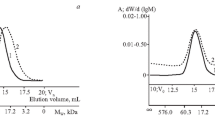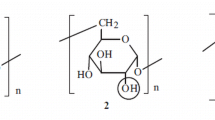Abstract
Colorimetric or potentiometric titration of the aldehyde residues in polyaldehyde dextran by the hydroxylamine hydrochloride/sodium hydroxide method has been found to be a convenient and accurate method to determine formyl content. Nitrogen combustion analyses on the isolated oximes confirmed the titrametric results.
Similar content being viewed by others
REFERENCES
N. D. Heindel, H. Zhao, M. R. Miller, G. T. Lautenslager, E. A. Nau, J. L. Burton, and J. H. Abel. Synthesis and dextran conjugation of ellipticines for tumor cell targeting. Pharm. Res. 5:S-63 (1988).
O. D. Robert, L. S. Daniel, E. D. Johnson, D. L. Meyer, A. K. James, and M. F. James. Preclinical trials with combinations and conjugates of T101 monoclonal antibody and doxorubicin. Cancer Res. 46:4886–4891 (1986).
M. Azori, J. Pato, E. Csakvari, and F. Tudos. Polymeric prodrug. Dextran-bound antirheumatic agent Naproxen. Makromol. Chem. 187:2073–2080 (1986).
M. Y. Hsin and A. R. Ralph. Doxorubicin conjugated with a monoclonal antibody directed to a human melanoma-associated proteoglycan. Proc. Natl. Acad. Sci. USA 85:1189–1193 (1988).
D. Shouval, R. Adler, J. R. Wands, and E. Hurwitz. Conjugates between monoclonal antibodies to HBsAg and cytosine arabinoside. J. Hepatol. 3(Suppl. 2):S87 (1986).
N. D. Heindel, H. Zhao, J. Leiby, J. M. Vandongen, C. J. Lacey, D. A. Lima, B. Shabsoug, and J. H. Buzby. Hydrazide Pharmaceuticals as conjugates to polyaldehyde dextran. Bioconj. Chem. 1:77–82 (1990).
J. F. Robyt and W. J. Whelan. Reducing value methods for maltodextrains, I. Anal. Biochem. 45:510–516 (1972).
R. H. Reiner and H. G. Batz. Periodic acid-oxidized soluble polysaccharides as polyfunctional links for covalent binding of enzymes. Makromol. Chem. 182:1641–1648 (1981).
R. O. Dillman, D. E. Johnson, D. L. Shawler, and J. A. Koziol. Superiority of an acid-labile daunorubicin-monoclonal antibody immunoconjugate compared to free drug. Cancer Res. 48:6097–6102 (1988).
J. F. Robyt, R. J. Ackerman and J. G. Keng. Reducing value methods for maltodextrins, II. Anal. Biochem. 45:517–524 (1972).
A. Bernstein, E. Hurwitz, R. Maron, R. Arnon, M. Sela, and M. Wilchek. Higher antitumor efficacy of daunomycin when linked to dextran. J. Natl. Cancer Inst. 60:379–384 (1978).
L. Molteni. Dextran and inulin conjugates as drug carriers. Methods Enzymol. 112:285–298 (1985).
J. S. Fritz, S. S. Yamamura, and E. C. Bradford. Determination of carbonyl compounds. Anal. Chem. 31:260–264 (1959).
R. V. Dilts. Analytical Chemistry, D. Van Nostrand, New York, 1974, pp. 83–87.
R. F. Culmo. Elemental Analysis Newsletter, Perkin Elmer Co., Norwalk, CT, 1988, p. 3.
Author information
Authors and Affiliations
Rights and permissions
About this article
Cite this article
Zhao, H., Heindel, N.D. Determination of Degree of Substitution of Formyl Groups in Polyaldehyde Dextran by the Hydroxylamine Hydrochloride Method. Pharm Res 8, 400–402 (1991). https://doi.org/10.1023/A:1015866104055
Issue Date:
DOI: https://doi.org/10.1023/A:1015866104055




